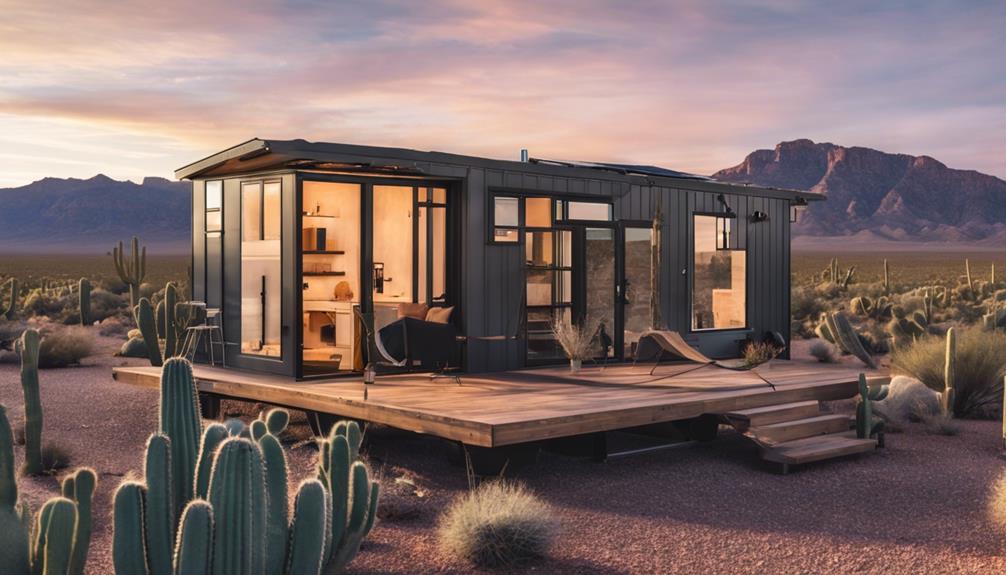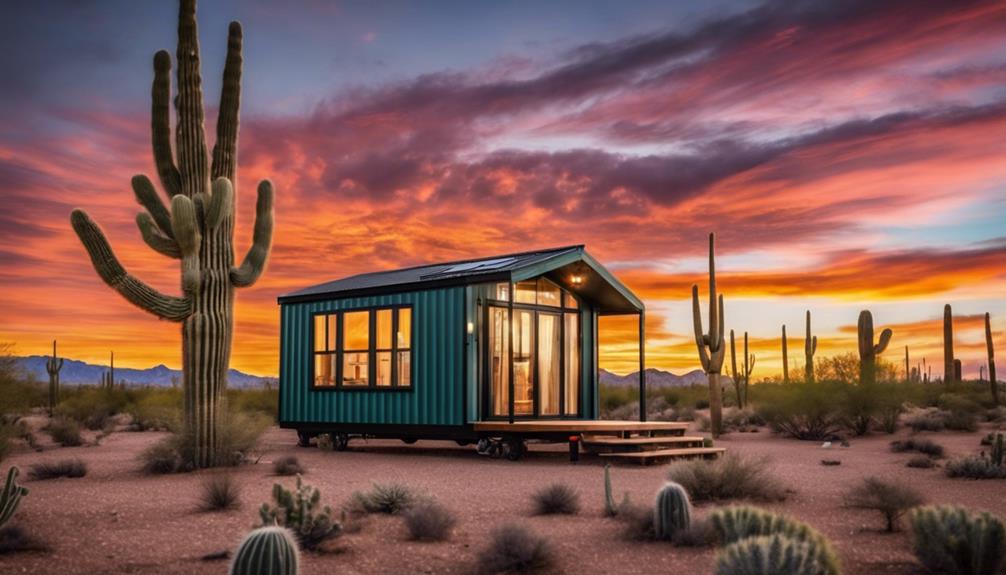Architecture Home Styles
Strong Yet Light: 7 Metals That Strike the Perfect Balance
Only through a delicate dance of strength and lightness can these seven metals redefine what's possible – discover their secrets within.

As we journey through the realm of metals, we uncover a fascinating interplay between strength and weight that captivates the minds of innovators. Exploring the delicate balance between durability and lightness, these seven metals stand as exemplars of engineering marvels.
Each metal in its own right embodies a unique blend of robustness and agility, paving the way for groundbreaking advancements in various industries. But what exactly sets these metallic wonders apart and makes them the ideal choice for modern applications? Let's unravel the mystery together.
Key Takeaways
- Titanium, aluminum, magnesium, and beryllium offer exceptional strength-to-weight ratios.
- These versatile metals find applications in aerospace, automotive, and high-tech industries.
- Innovative metal alloys like titanium aluminides and lithium drive technological advancements.
- The future lies in high-strength, lightweight metals for sustainable practices and aerospace engineering evolution.
Titanium: The Lightweight Powerhouse
Titanium, renowned for its exceptional strength-to-weight ratio, stands as a premier choice in industries such as aerospace, medicine, and sports equipment. With a density approximately half that of steel, titanium achieves a perfect balance between high strength properties and lightweight characteristics. Its remarkable strength allows for the creation of robust structures while maintaining a light overall weight, a critical aspect in applications where weight reduction is paramount.
The corrosion resistance and biocompatibility of titanium further enhance its appeal, particularly in the medical field for implants and surgical instruments. Its toughness and durability make it suitable for demanding applications like racing cars and high-end bicycles, where reliability is essential.
Titanium's versatility extends to the realms of luxury watches, elegant jewelry, and modern architectural designs, showcasing its aesthetic appeal across diverse industries. In essence, titanium embodies a harmonious blend of strength, lightweight properties, and adaptability, making it a powerhouse material for cutting-edge innovations.
Aluminum: Versatile Strength in Every Application

Aluminum's exceptional versatility and strength render it a fundamental component across a multitude of applications, ranging from aerospace to construction industries. This remarkable metal stands out due to its unique properties:
- High Strength-to-Weight Ratio: Aluminum's strength is unmatched relative to its weight, making it a top choice for aerospace and automotive components.
- Corrosion-Resistance: Its ability to withstand corrosion makes aluminum perfect for outdoor and marine applications where exposure to harsh elements is a concern.
- Recyclability: Nearly 75% of all aluminum ever produced is still in use today, showcasing its sustainability and eco-friendliness.
- Malleability: Aluminum's malleable nature allows for intricate designs and shapes, enabling its extensive utilization in modern manufacturing processes.
- Widespread Applications: From structural components to everyday products, aluminum's versatility knows no bounds, contributing to its ubiquitous presence in various industries.
Aluminum truly exemplifies strength combined with adaptability, making it a cornerstone material in the pursuit of innovation and efficiency.
Magnesium: Light as a Feather, Strong as Steel

Magnesium is renowned for its exceptional lightweight properties, outperforming even aluminum with a weight that's approximately 30% lighter.
This metal's strength, on the other hand, rivals that of steel, making it an attractive choice for applications requiring structural integrity.
The high strength-to-weight ratio of magnesium alloys has found extensive use in aerospace and automotive industries due to their superior performance characteristics.
Magnesium's Weight Advantage
With its exceptional strength-to-weight ratio and hexagonal close-packed crystal structure, the lightweight metal known for its durability and weight savings is magnesium. When considering magnesium's weight advantage, several key points stand out:
- Magnesium is 36% lighter than aluminum, making it the lightest structural metal available.
- Despite its light weight, magnesium has a high strength-to-weight ratio, rivaling that of steel.
- Magnesium alloys are commonly used in aerospace and automotive industries for their lightweight and strong properties.
- The strength of magnesium comes from its hexagonal close-packed crystal structure, providing excellent mechanical properties.
- Magnesium's exceptional strength and lightness make it a preferred choice for applications requiring both durability and weight savings.
Strength in Magnesium Alloy
Known for its exceptional strength-to-weight ratio and widely recognized in industries for its unique balance of strength and weight savings, magnesium alloys stand out as a favored choice for applications requiring lightweight yet durable materials.
These alloys, as light as aluminum but with mechanical properties comparable to some steels, offer a remarkable combination of traits. Industries such as aerospace, automotive, and electronics extensively utilize magnesium alloy components due to their high specific strength and stiffness. In aerospace, the lightweight nature of magnesium alloys contributes significantly to fuel efficiency and overall performance enhancements.
Ongoing research focuses on optimizing magnesium alloys further through alloying, processing, and surface treatments to enhance their strength and performance characteristics. Magnesium alloys continue to be at the forefront of innovation, pushing the boundaries of what's possible in lightweight yet robust material applications.
Beryllium: The Secret Weapon for Lightweight Durability

In the realm of materials engineering, beryllium emerges as a secret weapon for achieving lightweight durability in critical applications. Beryllium's unique combination of properties sets it apart in the quest for materials that can strike a balance between strength and weight.
Here are some key points that highlight why beryllium is a top contender in the realm of lightweight durability:
- Exceptional strength-to-weight ratio surpassing many other metals.
- High thermal conductivity, making it suitable for aerospace and high-tech industries.
- Low coefficient of thermal expansion, ensuring stability in various environments.
- Toxicity concerns demand strict safety protocols during handling and processing.
- Valuable for critical components in satellites, aircraft, and precision instruments.
Innovators seeking to push the boundaries of what's possible in materials science recognize beryllium as a valuable asset in creating lightweight yet durable solutions for the challenges of tomorrow.
Scandium: Unleashing Strength With Minimal Weight

Scandium, a lightweight metal comparable in density to aluminum, exhibits exceptional strength properties that make it a sought-after material in various high-tech industries. Its remarkable strength-to-weight ratio is particularly valuable in aerospace applications, where reducing weight without compromising structural integrity is crucial.
Scandium alloys are favored for sports equipment such as baseball bats and bicycle frames, where the combination of strength and lightness enhances performance. Additionally, the incorporation of scandium into aluminum alloys can significantly improve weldability and corrosion resistance, making it a versatile choice for various engineering applications.
Despite its rarity and cost, the unique properties of scandium justify its use in specialized industries that prioritize cutting-edge solutions. By leveraging scandium's strength with minimal weight, manufacturers can push the boundaries of innovation and create products that excel in performance while meeting the demands for lighter, stronger materials in the modern world of technology.
Lithium: Light and Mighty for Advanced Technologies

With its unparalleled lightweight properties and exceptional electrochemical characteristics, lithium stands out as a key element driving advancements in various high-tech sectors.
- Lithium is the lightest metal, ideal for lightweight applications in advanced technologies.
- Excellent electrochemical properties make it a popular choice for rechargeable batteries in smartphones and electric vehicles.
- High energy density and low weight contribute to its use in portable electronics and energy storage solutions.
- Abundance and recyclability support sustainability in the growing demand for lithium-ion batteries.
- Unique properties enable efficient energy storage, driving innovation in renewable energy systems and portable electronic devices.
Lithium's versatility in energy storage systems and portable electronics underscores its importance in the technological landscape. As a key component in rechargeable batteries and energy solutions, lithium plays a crucial role in advancing sustainable practices and powering the future of high-tech industries.
Titanium Aluminides: The Future of High-Strength, Lightweight Metals

Titanium aluminides showcase remarkable strength-to-weight ratios, positioning them as promising contenders for high-performance applications in aerospace industries.
Their ability to withstand elevated temperatures while maintaining structural integrity underscores their suitability for demanding operational environments.
The precise crystal structures of titanium aluminides play a pivotal role in their exceptional mechanical attributes and resistance to corrosion and oxidation.
Titanium Aluminides Properties
In high-strength, lightweight metals, the properties of titanium aluminides stand out prominently due to their exceptional strength-to-weight ratio. These intermetallic compounds exhibit high strength at elevated temperatures, making them ideal for aerospace and automotive applications.
Titanium aluminides offer excellent creep resistance and oxidation resistance, enhancing their durability in extreme environments. Their specific crystal structure contributes to their unique mechanical properties, setting them apart from traditional metal alloys.
Ongoing research and development efforts aim to optimize the processing and properties of titanium aluminides for advanced engineering applications.
- Exceptional strength-to-weight ratio
- High strength at elevated temperatures
- Excellent creep resistance and oxidation resistance
- Unique crystal structure
- Ongoing research for advanced engineering applications
Applications in Aerospace
Aerospace industries increasingly rely on the unique properties of titanium aluminides for enhancing performance and efficiency in aircraft design. These materials offer a remarkable balance of high strength and low weight, making them well-suited for a variety of aerospace applications.
With exceptional mechanical properties such as high temperature resistance and a superior strength-to-weight ratio, titanium aluminides are becoming integral to aircraft engines, structural components, and other critical parts within the aerospace sector.
The evolution of titanium aluminides signifies a significant advancement in material science, paving the way for the development of lightweight yet robust metals.
The future of aerospace engineering hinges on the continued utilization of titanium aluminides to achieve optimal performance and efficiency in aircraft design.
Frequently Asked Questions
How Are These Metals Commonly Used in Everyday Applications?
We commonly use these metals in everyday applications due to their exceptional properties. They offer a unique balance of strength and lightness, making them ideal for various uses.
From aerospace components to sports equipment, these metals provide durability without adding unnecessary weight. Their versatility allows us to innovate and create products that are both reliable and efficient in diverse fields.
What Are the Main Differences Between These Metals in Terms of Strength and Weight?
When comparing these metals in terms of strength and weight, we find significant differences. Some metals excel in strength but are heavier, while others strike a balance by being both strong and light.
Understanding these distinctions is crucial for selecting the right material for specific applications. By analyzing the unique properties of each metal, we can harness innovation to optimize performance and efficiency in various industries.
Are There Any Potential Health or Environmental Concerns Associated With Using These Metals?
Potential health and environmental concerns regarding these metals must be scrutinized. We aim to delve into any risks associated with their usage.
Like a skilled detective, we'll analyze each metal's impact on both human health and the environment. By exploring these factors thoroughly, we can make informed decisions to ensure the safety and sustainability of utilizing these metals in various applications.
Can These Metals Be Easily Recycled or Reused?
Yes, these metals can be easily recycled or reused. Their unique properties make them ideal for efficient recycling processes. By utilizing advanced techniques, we can extract and repurpose these metals without compromising their quality.
This sustainable approach aligns with our commitment to minimizing waste and reducing environmental impact. Our innovative methods ensure that these metals retain their strength and lightness throughout their lifecycle, contributing to a more eco-friendly future.
Are There Any Emerging Technologies or Industries That Are Driving the Demand for These Lightweight Metals?
Emerging technologies and industries are propelling the demand for these lightweight metals to new heights. From aerospace advancements seeking stronger, lighter materials to electric vehicle manufacturers aiming to enhance efficiency, the allure of these metals is undeniable.
As innovation drives us forward, the need for materials that strike the perfect balance between strength and weight becomes increasingly crucial. These metals are at the forefront of a revolution in technology and industry.
Conclusion
In conclusion, these 7 metals epitomize the perfect balance of strength and lightness, paving the way for groundbreaking advancements in technology. Like a symphony of elements harmonizing in perfect unison, they showcase the delicate dance of metal-light interactions.
As we delve deeper into this intricate relationship, we unlock a world of possibilities for innovation and progress. The future holds endless potential for technological marvels, all thanks to the remarkable properties of these metals.
- About the Author
- Latest Posts
Introducing Ron, the home decor aficionado at ByRetreat, whose passion for creating beautiful and inviting spaces is at the heart of his work. With his deep knowledge of home decor and his innate sense of style, Ron brings a wealth of expertise and a keen eye for detail to the ByRetreat team.
Ron’s love for home decor goes beyond aesthetics; he understands that our surroundings play a significant role in our overall well-being and productivity. With this in mind, Ron is dedicated to transforming remote workspaces into havens of comfort, functionality, and beauty.
Architecture Home Styles
How to Have a Tiny Home in Arizona: Your Essential Guide
Fascinated by the idea of a tiny home in Arizona? Discover how tax considerations can impact your journey in this essential guide.

Embarking on the journey of having a tiny home in Arizona is like navigating through a desert oasis, each step revealing new insights and challenges. From understanding the intricate web of zoning laws to discovering the perfect location that aligns with your tiny living dreams, this essential guide equips you with the knowledge needed to turn your tiny home vision into reality.
But what about the unique tax considerations that come with owning a tiny home in Arizona? Stay tuned to uncover key insights that will make a difference in your tiny home journey.
Key Takeaways
- Understand Arizona zoning laws for placement in suitable zones.
- Seek permits for tiny homes based on location and structure type.
- Explore tax benefits for tiny homeowners through property tax exemptions.
- Build a supportive community through local groups and events for guidance.
Zoning Laws and Regulations in Arizona
When navigating the realm of tiny home living in Arizona, understanding the intricacies of zoning laws and regulations becomes paramount. In Arizona, zoning laws permit tiny houses on foundations in multifamily, detached single-family, and accessory dwelling unit zones.
However, for Tiny Homes on Wheels, they're typically classified as recreational vehicles and must adhere to specific parking regulations within designated zones. Maricopa County has established particular regulations for tiny houses, including constraints on the floor area allowed for permanent structures. On the other hand, Pima County imposes restrictions on Tiny Homes on Wheels through specific codes that govern their placement.
The zoning options for tiny houses in Arizona encompass various zones such as isolated single-family zones, accessory dwelling unit zones, and multifamily zones. Familiarizing oneself with these zoning laws and regulations is crucial for anyone considering embarking on the adventure of tiny home living in Arizona.
Ideal Locations for Tiny Homes

For those seeking ideal locations to establish their tiny homes in Arizona, cities like Phoenix, Tucson, Sedona, and Lakeside present attractive options. When considering where to set up your tiny home in Arizona, keep in mind that Pima County and Coconino County permit the establishment of tiny houses in specific zones. In these areas, tiny homes can be placed in isolated single-family zones, ADU zones, and multifamily zones. For those with tiny houses on wheels, it's important to note that they must be parked in designated R.V. zones in compliance with regulations.
- Phoenix, Tucson, Sedona, and Lakeside are ideal cities for setting up tiny homes in Arizona.
- Pima County and Coconino County allow tiny houses in specific zones.
- Tiny homes can be placed in single-family zones, ADU zones, and multifamily zones.
- Tiny houses on wheels must adhere to regulations in designated R.V. zones.
Tax Considerations for Tiny Home Owners
Exploring the tax implications of owning a tiny home in Arizona reveals potential benefits and considerations that can significantly impact financial planning for homeowners. Tiny home owners in Arizona may qualify for property tax exemptions based on factors like square footage and adherence to green building standards. Additionally, the size of tiny homes could lead to reduced property tax assessments in certain counties. It is crucial for Arizona tiny home owners to familiarize themselves with local tax laws to take advantage of any available tax benefits. Seeking guidance from a tax professional or local tax assessor can provide valuable insights into how owning a tiny home in Arizona may influence property taxes.
Tax Considerations for Tiny Home Owners:
| Key Points | Details | Importance |
|---|---|---|
| Property Tax Exemptions | Available based on square footage and green standards | Maximize Savings |
| Reduced Assessments | Smaller homes could mean lower tax bills | Financial Advantage |
| County Variances | Regulations differ, impacting tax benefits | Local Compliance |
| Professional Advice | Consult with tax professionals for guidance | Optimal Planning |
Finding Community Support in Arizona

By actively engaging with local resources and networking opportunities, tiny home enthusiasts in Arizona can establish a strong sense of community support to enhance their living experience.
Here are some ways to find community support in Arizona:
- Join local Facebook groups like 'Arizona Tiny House Community' for a supportive network.
- Attend tiny house meetups and events in Arizona to connect with like-minded individuals.
- Explore tiny house workshops and seminars in the state to gain knowledge and resources.
- Consider volunteering with non-profit organizations focused on sustainable living and tiny house advocacy in Arizona.
These opportunities not only provide a sense of belonging within the tiny house community but also offer valuable insights, resources, and support for those embracing the tiny home lifestyle in Arizona.
Engaging with these avenues can enrich your experience, foster connections, and empower you to navigate the challenges and joys of sustainable living in the state.
Building and Parking Tips for Tiny Homes
Engaging with the regulations and guidelines for building and parking tiny homes in Arizona is crucial for ensuring compliance and a smooth transition into sustainable living. Tiny homes on foundations in Arizona must adhere to the 2018 IRC Appendix Q requirements, which outline specific space dimensions and safety features to guarantee structural integrity.
Building a tiny home on skids offers a semi-permanent placement option while still allowing for mobility if relocation becomes necessary. For those opting for tiny homes on wheels, meeting mobile home requirements is essential, and a minimum of 160 square feet is required for parking.
The flexibility in setting up tiny homes in various zone types in Arizona provides diverse housing options based on individual preferences. Tiny houses on wheels are particularly popular for their mobility and flexibility, making them an attractive choice for those desiring a minimalist lifestyle without sacrificing comfort.
Frequently Asked Questions
Can I Put a Tiny House on My Property in Arizona?
Yes, we can put a tiny house on our property in Arizona if it complies with local zoning regulations. Different options like multifamily, detached single-family, or accessory dwelling units are available. Land near Maricopa City, Pinal County, offers accessible placement.
How Much Does a Tiny House Cost in Az?
Tiny houses in Arizona can range from $20,000 to $200,000 depending on size and customization. DIY kits start at $8,000, but labor costs add up. Land, utilities, and permits are extra. Building a tiny house can be a cost-effective housing choice.
What Is the Minimum Square Footage for a House in Arizona?
In Arizona, the minimum square footage for a house varies based on its foundation type. For tiny houses on foundations, it's 200 square feet, while those on trailers require at least 160 square feet. Adhering to building codes is essential.
Does Arizona Have a Tiny Home Community?
We do have tiny home communities in Arizona. These communities provide shared amenities, community engagement, and a supportive environment. Living in a tiny house community offers a unique sense of belonging, shared resources, and a close-knit experience.
Conclusion
In conclusion, navigating the world of tiny homes in Arizona may seem like a daunting task, but with the right resources and community support, it can be a breeze.
From zoning laws to building tips, we've covered it all in our essential guide.
So go ahead, take the leap into tiny home living and watch your dreams of a cozy, sustainable lifestyle come to life in the Grand Canyon State!
- About the Author
- Latest Posts
Introducing Ron, the home decor aficionado at ByRetreat, whose passion for creating beautiful and inviting spaces is at the heart of his work. With his deep knowledge of home decor and his innate sense of style, Ron brings a wealth of expertise and a keen eye for detail to the ByRetreat team.
Ron’s love for home decor goes beyond aesthetics; he understands that our surroundings play a significant role in our overall well-being and productivity. With this in mind, Ron is dedicated to transforming remote workspaces into havens of comfort, functionality, and beauty.
Architecture Home Styles
Exploring the Difference Between Traditional and Classic Design
Kickstart your journey into the world of design by uncovering the subtle yet significant distinctions between traditional and classic styles, shaping your perception of timeless elegance.

When considering traditional versus classic design, we uncover nuanced distinctions in style and aesthetic preferences. The interplay between historical influences and contemporary interpretations provides a fascinating insight into the evolution of design principles.
As we explore the intricate details and subtle nuances that set these two styles apart, it becomes evident that each offers a unique perspective on elegance and sophistication.
Stay tuned to unravel the intricacies that define the essence of traditional and classic design, shedding light on the nuances that shape our perception of timeless aesthetics.
Key Takeaways
- Traditional design features bold colors and intricate patterns, while classic design opts for soft and subdued colors for elegance.
- Both traditional and classic design styles focus on creating a balanced, inviting, and harmonious atmosphere.
- Traditional furniture embodies moderation and balance with solid wood, while classic furniture exudes nobility with gilded finishes.
- Lighting in traditional design aims for warmth and coziness, while classic design creates a luxurious ambiance with ornate fixtures.
Key Elements in Traditional Design
In traditional design, we intricately weave together elements of moderation, elegance, and balance to create a timeless aesthetic inspired by the rich European design traditions of the 18th and 19th centuries. Solid wood plays a pivotal role in this style, exuding warmth and coziness throughout the space. The choice of fabrics like cotton, leather, and velvet further enhances the comfort aspect, inviting you to sink into luxurious textures. Lighting is carefully curated to emanate a soft and inviting glow, achieved through the use of ambient sources such as table lamps and floor lamps, setting a cozy ambiance.
The color palette in traditional design is a symphony of rich colors like deep reds, lush greens, and vibrant yellows, adding depth and character to the space. These hues evoke a sense of opulence and sophistication, harmonizing beautifully with the overall design scheme. The blend of these elements creates a space that not only exudes elegance but also envelops you in a sense of comfort and luxury.
Characteristics of Classic Design

Transitioning from the rich tapestry of traditional design, classic design embodies a timeless allure through its emphasis on neutral hues, enduring furniture pieces, and ageless patterns. Classic design is about creating a space that feels elegant and sophisticated, never going out of style. This style incorporates traditional furniture pieces like wingback chairs and claw-foot tables, showcasing intricate details and a focus on symmetry. Antique or vintage items are often integrated into classic interiors to enhance the sense of heritage and history. Natural materials such as wood and marble play a significant role in classic design, adding a touch of authenticity and luxury. The use of neutral colors like beige, ivory, and taupe creates a serene and calming atmosphere, perfect for those who appreciate a refined aesthetic. Classic design is about capturing the essence of timeless beauty and creating a space that exudes grace and elegance.
| Characteristics | Description | Example |
|---|---|---|
| Neutral Colors | Create a serene atmosphere | Beige, Ivory, Taupe |
| Traditional Furniture | Emphasize heritage and sophistication | Wingback chairs, Claw-foot tables |
| Intricate Details | Showcase fine craftsmanship | Ornate carvings, Embossed patterns |
| Natural Materials | Add authenticity and luxury | Wood, Marble, Leather |
| Timeless Patterns | Enhance the sense of elegance | Damask, Toile, Houndstooth |
Color Palette Variances
Let's delve into the captivating interplay of colors in traditional and classic design, unveiling their distinct palettes and the emotions they evoke within interior spaces.
Traditional design is known for its bold use of color, incorporating rich tones like red, green, and yellow to create a lively and accented color palette. In contrast, classic design opts for a more subdued approach, favoring neutral and soft colors that convey timeless sophistication and elegance. Both styles share a common emphasis on proportion and harmony when selecting colors, ensuring a visually pleasing aesthetic within the space.
Classic design often showcases prestigious materials with subtle contrasts, exuding an air of understated luxury. On the other hand, traditional design tends to embrace vibrant colors and intricate patterns, adding a sense of energy and warmth to the room. The careful selection of color palettes in traditional and classic design plays a vital role in shaping the overall ambiance and character of the interior, showcasing a harmonious blend of elegance, proportion, and timeless sophistication.
Differences in Furniture Styles

Embarking on a journey through the realm of interior design, we are met with a striking divergence in furniture styles between traditional and classic design aesthetics. Traditional furniture in European design, originating from the 18th and 19th centuries, embodies moderation, elegance, and balance. On the other hand, classic furniture exudes noble atmospheres with pomposity, showcasing prestigious materials like oak, mahogany, ceramic, marble, gold, and silver finishes.
| Traditional Furniture | Classic Furniture |
|---|---|
| Rooted in European design | Exudes ethereal nobility |
| Favoring moderation | Prestigious materials |
| Warmth and coziness | Gilded and opulent |
In traditional style, harmony is achieved through blending various elements, offering warmth and coziness with solid wood furniture and fabrics like cotton, leather, and velvet. In contrast, classic style features gilded finishes and gold leaf for a luxurious look, emphasizing richness and opulence. These styles also extend into lighting design, with traditional opting for warmer and softer lighting, creating a cozy feel with ambient lighting solutions like table lamps and floor lamps, while classic style leans towards ornate chandeliers and sconces for a grandiose touch.
Lighting Design Variances
As we delve into the realm of lighting design variances, a captivating interplay emerges between classic and traditional interior styles, each illuminating spaces with unique charm and character. Classic design exudes richness and opulence through lighting fixtures like grand chandeliers and intricately detailed sconces. These ornate details in classic lighting fixtures create a luxurious ambiance, evoking a sense of grandeur and sophistication within a space.
On the other hand, traditional design takes a softer approach, opting for warmer and cozier lighting solutions such as table lamps and floor lamps. The emphasis in traditional design is on creating a welcoming and comfortable environment, where ambient lighting plays a pivotal role in setting the mood. This style aims to promote a sense of intimacy and relaxation, steering away from the grandiose nature of classic design.
Both classic and traditional design styles strive for elegant lighting options that not only serve a functional purpose but also enhance the overall ambiance of a room. Whether it's the opulence of classic chandeliers or the cozy feel of traditional table lamps, lighting design plays a crucial role in shaping the character of a space.
Frequently Asked Questions
How Is Traditional Design Different From Modern Design?
Traditional design differs from modern design in various aspects.
We see traditional design focusing on warmth and rich colors like red and green, while modern design emphasizes sleek lines and minimalism.
Traditional design incorporates natural materials like wood for a cozy atmosphere, whereas modern design utilizes innovative materials for a contemporary look.
The former favors classic furniture with intricate details, while the latter features unique furniture and cutting-edge designs.
What Is the Definition of Traditional Design?
When it comes to traditional design, it's like stepping into a cozy retreat filled with elegant charm. Rich colors like red, green, and yellow dance together, creating a lively palette.
Classic lines and solid wood furniture greet you warmly, while fabrics like cotton and velvet whisper comfort and luxury. It's a timeless style that wraps you in a familiar embrace, making every corner of your home feel like a cherished memory.
What Is the Difference Between Modern Design and Classic Design?
When it comes to modern design and classic design, the distinction lies in their contrasting aesthetics.
Modern design embodies sleek lines and cutting-edge materials, reflecting a contemporary and innovative vibe.
In contrast, classic design exudes elegance and timeless sophistication with its traditional furniture and luxurious details.
These two styles offer a unique blend of old-world charm and futuristic elements, catering to different tastes and preferences in the world of design.
What Is the Difference Between Modern and Classic Home Design?
When it comes to modern and classic home design, the distinction lies in their essence.
Modern design embodies innovation and creativity with sleek lines and cutting-edge materials, ideal for those seeking a contemporary aesthetic.
Classic design, on the other hand, exudes elegance and sophistication through timeless pieces and intricate details, appealing to those who value tradition and refinement in their living spaces.
These contrasting styles offer unique choices for expressing personal taste and style preferences.
How Does Traditional Design Differ from Classic Design in Terms of Aesthetics and Functionality?
Traditional design encompasses a more ornate and intricate aesthetic, while classic design focuses on simplicity and elegance. In terms of functionality, traditional design often prioritizes practicality, while classic design may incorporate more decorative elements. The main difference between modern design and traditional design lies in their approach to aesthetics and practicality.
Conclusion
As we wrap up our exploration of traditional and classic design, it's clear that these styles offer unique and distinct characteristics. From the cozy warmth of traditional design to the timeless elegance of classic design, each style brings its own charm and sophistication to any space.
Whether you prefer the rich colors and intricate details of traditional design or the opulent finishes and neutral palettes of classic design, there's no doubt that both styles can create a truly stunning and inviting atmosphere.
So, which style speaks to you?
- About the Author
- Latest Posts
Introducing Ron, the home decor aficionado at ByRetreat, whose passion for creating beautiful and inviting spaces is at the heart of his work. With his deep knowledge of home decor and his innate sense of style, Ron brings a wealth of expertise and a keen eye for detail to the ByRetreat team.
Ron’s love for home decor goes beyond aesthetics; he understands that our surroundings play a significant role in our overall well-being and productivity. With this in mind, Ron is dedicated to transforming remote workspaces into havens of comfort, functionality, and beauty.
Architecture Home Styles
How to Explore Native Houses in Indonesia
Catch a glimpse of Indonesia's cultural treasures through native houses, where each intricate detail holds a secret waiting to be discovered.

So, you think you've seen it all in Indonesia? Well, think again. Exploring native houses in this diverse archipelago offers a glimpse into a world where tradition meets craftsmanship in a harmonious blend.
From the intricate carvings to the unique architectural designs, each house tells a story waiting to be uncovered, inviting us to step into a realm where time seems to stand still.
But what lies beyond the façade of these cultural gems is a journey that promises to unravel the tapestry of Indonesia's rich heritage, revealing a side often overlooked by many travelers.
Key Takeaways
- Visit Batak, Toraja, and Joglo Houses for diverse architectural experiences.
- Discover intricate carvings and symbolic details in traditional Indonesian homes.
- Immerse in cultural heritage through communal spaces and ancient craftsmanship.
- Learn about Indonesia's rich history and values by exploring native houses.
Traditional Houses in Indonesia
In Indonesia, traditional houses embody rich cultural heritage through their unique architectural designs and symbolism. Among these remarkable dwellings, the boat-shaped houses stand out for their distinctive characteristics. The Batak House, found in certain regions, showcases intricate carvings and utilizes natural materials, reflecting a deep connection to the environment. These boat-shaped structures not only serve as homes but also as symbols of cultural identity and traditions passed down through generations.
The boat-shaped design of these traditional houses in Indonesia not only provides shelter but also represents a deeper meaning within the community. The intricate carvings on the Batak House, for example, tell stories of ancestry and spiritual beliefs, adding layers of significance to the architectural aesthetics. Through these boat-shaped dwellings, the indigenous peoples of Indonesia honor their heritage and preserve their cultural roots in a rapidly changing world.
Cultural Significance of Indigenous Dwellings

Exploring the intricate cultural significances embedded within indigenous dwellings in Indonesia unveils a tapestry of architectural symbolism and traditional values that resonate deeply within the communities they inhabit. These houses serve as more than mere shelters; they embody the cultural beliefs and practices of the diverse Indonesian tribes. The multi-generational living arrangements seen in houses like the Rumah Gadang in West Sumatra and the Rong Houses in Dayak communities highlight the importance of family and community ties in Indonesian society.
Moreover, the communal living spaces found in the Tongkonan House in Tana Toraja and the Uma Lulik in Timor foster a sense of togetherness and shared responsibilities among the inhabitants. Each architectural element, from the intricate carvings to the circular shapes and elevated stilts, holds deep symbolic meaning rooted in centuries-old traditions. These indigenous dwellings aren't just physical structures but living embodiments of Indonesia's rich cultural heritage, where every beam and wall tells a story of cultural continuity and communal harmony.
Top Native Houses to Visit
With intricate architectural designs and rich cultural symbolism, a journey to explore the top native houses in Indonesia promises a captivating immersion into the country's diverse heritage. Here are some of the top native houses you shouldn't miss:
| Native House | Features |
|---|---|
| Batak Houses | Boat-shaped roofs, intricate carvings, spaces for daily life activities like a living room and dining room. |
| Toraja Houses | Distinct saddleback roof design, used in ceremonies, areas for daily life such as a living room and dining room. |
| Joglo Houses | Elaborate wooden structures, symbolizing social hierarchy, with designated spaces for a living room and dining room. |
These native houses offer insights into the daily lives of the people inhabiting them. From the communal spaces like the living room where gatherings take place to the dining room where meals are shared, each house reflects the cultural practices and traditions of its respective community. Exploring these spaces provides a unique opportunity to understand the interconnectedness between architecture, daily life, and cultural identity in Indonesia.
Exploring Architectural Features

Amidst the vibrant tapestry of Indonesia's architectural landscape, one encounters a rich mosaic of cultural intricacies within the native houses that stand as living testaments to the country's diverse heritage. As we delve into exploring the architectural features of these remarkable dwellings, we're greeted by a fusion of craftsmanship and symbolism that captivates the senses:
- Boat-shaped roofs that gracefully mimic the curves of traditional Indonesian vessels, offering a nod to the nation's maritime history.
- Intricate carvings adorning the facades and interiors, telling stories of myths, legends, and ancestral wisdom.
- Wooden craftsmanship that showcases the mastery of artisans, each piece meticulously crafted to perfection.
- Natural materials seamlessly integrated into the structures, connecting the homes to the earth and reflecting a harmonious relationship with nature.
- Symbolic details embedded in every corner, from the layout to the decorations, embodying cultural beliefs and societal values passed down through generations.
Exploring these architectural marvels unveils a world where history, artistry, and tradition converge in a celebration of Indonesia's rich cultural heritage.
Immersing in Indonesian Hospitality
Immerse yourself in the captivating tapestry of traditional Indonesian hospitality by residing in native houses like the Batak House in North Sumatra or the Rumah Gadang in West Sumatra. These native houses not only offer a place to stay but also provide a gateway to the cultural heritage of Indonesia. The intricate carvings, boat-shaped roofs, and eco-friendly construction of these houses showcase the deep-rooted traditions and craftsmanship of the local communities.
Here is a table highlighting some of the unique aspects of traditional Indonesian hospitality found in native houses:
| Aspect | Description |
|---|---|
| Architectural Features | Intricate carvings, boat-shaped roofs |
| Social Significance | Symbolism of social hierarchy in houses like the Joglo House in Central Java |
| Eco-Friendly Construction | Use of sustainable materials like bamboo and thatch in houses like the Sasak House in Lombok |
| Spiritual Connections | Preservation of spiritual connections and communal living traditions in houses like the Uma Lulik in Timor or the Honai House in Papua |
| Local Way of Life | Experience the daily lives and customs of the local communities while staying in these native houses |
Staying in these native houses will not only provide you with a unique accommodation experience but also a deep dive into the rich tapestry of Indonesian traditions and hospitality.
Frequently Asked Questions
What Are Traditional Indonesian Houses Called?
Traditional Indonesian houses are called 'Rumah Adat.' These structures are more than just dwellings; they're living representations of Indonesia's rich cultural tapestry. Crafted from natural materials like wood and thatch, they stand as testaments to the country's diverse traditions.
Each region boasts its own unique design, influenced by local customs and beliefs. Exploring these native houses allows us to delve into the heart of Indonesia's vibrant heritage and architectural ingenuity.
What Is Indonesian Housing Like?
Indonesian housing embodies a rich tapestry of cultures and traditions, showcasing unique architecture and sustainable practices. From boat-shaped roofs to intricate carvings, these homes reflect a deep connection to nature and community.
Families often live together in multi-story structures, fostering bonds and kinship. Sustainability and cultural symbolism intertwine in Indonesian homes, creating a harmonious blend of functionality and heritage preservation.
Each dwelling tells a story of tradition, innovation, and unity.
What Is Typical Indonesian Housing?
We'll dive into the essence of typical Indonesian housing, showcasing the diverse array of styles like Batak, Toraja, Joglo, and more. These houses boast unique architectural features, reflecting the rich heritage of Indonesia's indigenous communities.
From intricate carvings to bamboo and thatch construction, each house tells a story of cultural significance and tradition. Multi-generational living arrangements further deepen the bond between people, highlighting the social and spiritual connections within the community.
What Is a House Called in Indonesia?
In Indonesia, a house is often referred to as a 'rumah' in Bahasa Indonesia. These structures aren't merely places of dwelling; they embody the essence of Indonesian culture and heritage.
Each region has its unique names for traditional houses, such as 'rumah adat' or 'rumah suku,' showcasing the diverse architectural styles and craftsmanship.
These homes serve as living monuments, reflecting the country's history, beliefs, and social structure.
Conclusion
In conclusion, exploring native houses in Indonesia is like taking a journey through a living museum of cultural heritage. Each traditional dwelling tells a story of the past and present, showcasing the craftsmanship and traditions of its people.
By immersing ourselves in these architectural wonders, we can truly appreciate the beauty and diversity of Indonesia's indigenous cultures. So, let's hit the road and dive into the rich tapestry of Indonesian history – the world is our oyster!
- About the Author
- Latest Posts
Introducing Ron, the home decor aficionado at ByRetreat, whose passion for creating beautiful and inviting spaces is at the heart of his work. With his deep knowledge of home decor and his innate sense of style, Ron brings a wealth of expertise and a keen eye for detail to the ByRetreat team.
Ron’s love for home decor goes beyond aesthetics; he understands that our surroundings play a significant role in our overall well-being and productivity. With this in mind, Ron is dedicated to transforming remote workspaces into havens of comfort, functionality, and beauty.
-

 Vetted40 mins ago
Vetted40 mins ago15 Best Silver Polish Brands to Make Your Silver Shine Like New
-

 Vetted5 days ago
Vetted5 days ago15 Best Fillers for Concrete Cracks – Expert Recommendations and Reviews
-

 Vetted1 week ago
Vetted1 week ago15 Best Plants for Large Pots to Transform Your Outdoor Space
-

 Vetted6 days ago
Vetted6 days ago15 Best Fairy Lights to Transform Your Space With Magical Illumination
-

 Vetted1 week ago
Vetted1 week ago15 Best Folding Beds for Small Spaces – Space-Saving Solutions for Comfort and Convenience
-

 Vetted1 week ago
Vetted1 week ago15 Best Waterproof Flooring Options for Your Bathroom – Ultimate Guide & Reviews
-

 Vetted2 weeks ago
Vetted2 weeks ago15 Best Grocery Carts to Make Shopping a Breeze
-

 Vetted1 day ago
Vetted1 day ago15 Best Subfloor Options for Your Basement Renovation – Ultimate Guide





















